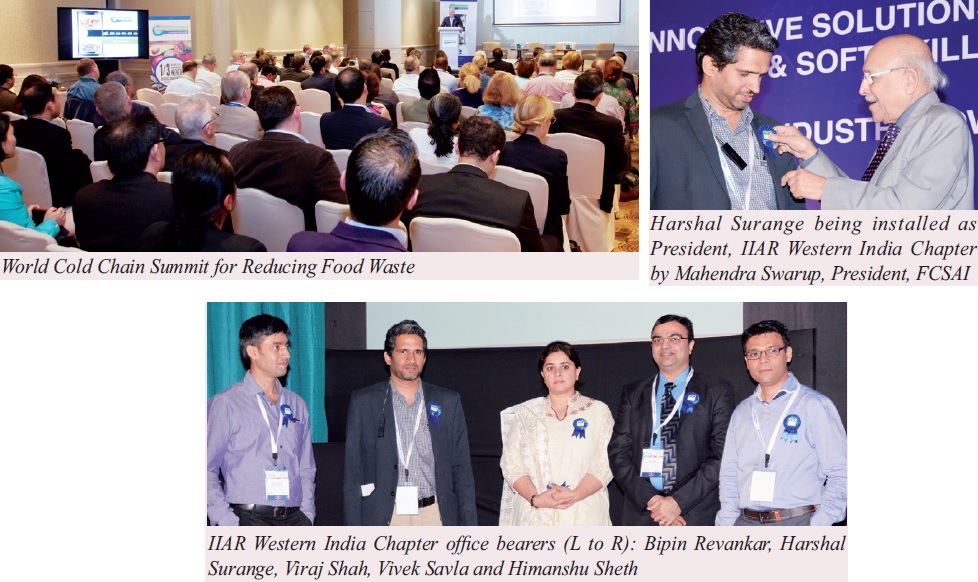Air Conditioning and Refrigeration Journal of ISHRAE is a great way to connect with the refrigeration and cold chain fraternity, and this issue would be released close to ACREX, which is the flagship show of the HVACR Industry in India. A few important events have led us to believe that as more and more interest develops in the refrigeration and cold chain industry, the growth story is slowly beginning to unfold and newer large projects are coming up. The reason behind ‘standing tall’ comes from Pawanexh Kohli, CEO of NCCD, who has always felt that inspite of all odds that we face
as a country, inspite of the infrastructural challenges, we have several cold chain success stories, some of them being: eradication of Polio from a peak of 350,000 infected per year, being amongst the world’s top ten exporters of grapes, being among the largest exporters of poultry and eggs, and having the world’s largest dairy production and consumption (for which a fully developed cold chain is a must). We have a very good cold chain in the sea-food sector, though a lot still needs to be done. Looking at other countries, we have come a long way and our processed food loss is still very low compared to other countries. Stand tall, India! Your time has come.
ISHRAE Goes to Dubai
In a meeting of the partners to the Montreal Protocol held in Dubai, ISHRAE participated in the side event on non-HFC food cold chain. The seminar was organized by Terre Policy, India. Arvind Surange and Sharang Natu represented ISHRAE and made a presentation on the Indian scenario. Samir Shah also spoke on behalf of IIAR, USA. Dr. Rajendra Shende, Chair, Terre Policy anchored the event with his own views on the topic. It was a rare occasions when ISHRAE was represented at an International Convention of this level. The main 5-day event was attended by representatives from
over 120 countries.
Event-Packed Months
There were many events on refrigeration that took place in the last quarter or so, namely ACR TrendZ by ISHRAE Pune Chapter in Pune, ICE by Global Cold Chain Alliance in Chandigarh, India Cold Chain Show by Reed Manch Communications (held along with India Warehousing Show) at Mumbai, etc. A training program organized by NCCD at Cemafroid, Paris for the Indian cold chain sector (unfortunately, post the Paris terrorist attack, these are on the slow track now), and World Cold Chain Summit for Reducing Food Waste held in Singapore were the other important
events attended by the author.
IIAR Western India Chapter
An important development, which was mentioned earlier in this column, is the formation of the first IIAR Chapter in India – IIAR Western India Chapter. IIAR (International Institute of Ammonia Refrigeration) is headquartered in the USA, and this is its first chapter in India. We are sure it will add immense value to the Indian refrigeration sector, since its composition includes a significant mix of end-users, contractors, manufacturers,
consultants, academics, and other stakeholders. IIAR has a number of quality publications and standards on ammonia and other natural refrigerants, which are of great value to the industry. Harshal Surange has been elected the Founder President of the Chapter and he, along with other board members Vivek Savla (President Elect), Viraj Shah (Vice President), Bipin Revankar (Treasurer) and Himanshu Sheth were installed at the hands of the President and board members of Federation of All India Cold Store Associations (FAICSA). With ISHRAE also taking a step in the right direction by forming a Standing Committee on Refrigeration, a symbiotic relationship is on the cards. India Cold Chain Conference 2015 India Cold Chain Show also hosted a seminar on various interesting topics. There was a separate meeting between the Director of NIFTEM Dr. Ajit Kumar and NIFTEM advisor Dr. R. K. Sharma and cold chain owners and consultants to discuss the challenges and to prepare a roadmap for training of cold chain personnel in India. A meeting of the Navi Mumbai Association of Cold Storage Owners and Maha Cold Storage Association (a newly formed body of the cold storage and food processing owners and operators of Maharashtra that officially joined FAICSA during the meeting) was hosted on the sidelines. The meeting raised some very important pan-India issues:
a. Insurance Categorisation as Hazardous
Fire insurance premium for cold storages is higher than most industrial units as cold storage activity is considered hazardous. This approach has also been observed in the fire extinguisher norms inIndian Standard IS 2190: 1992, where cold storage is considered a high hazard activity. Insurance companies refer to this standard. Some multi-national insurance companies are even refusing to insure cold storages. A change in this perception of the cold storage industry will help in reducing insurance costs.
b. Central Pollution Control Board (CPCB) Categorisation
CPCB and MPCB have changed the categorisation of ammoniabased cold storages from Green to Orange. No explanation has been given for this negative change. Cold storage is clearly a non-polluting activity and this change is causing a lot of unnecessary frustration while obtaining the MPCB certificate and interacting with MPCB officials.
c. Service Tax on Cold Storage Activity
Currently Service Tax is applicable to the storage of processed products. Barring very few products like potato and apple, no other products can be stored in cold storage for preservation in their natural form for a long period. To ensure longer shelf life, better pricing to farmers, product availability in the lean season and controlling inflation, processing is almost mandatory for most agricultural produce. Thus, in line with the national agenda of promoting agriculture and related activities, both fresh and processed agricultural produce must be exempt from Service Tax. The impact of Service Tax is felt more adversely in Maharashtra, since a majority of the cold storages there are multi-commodity storages, storing predominantly processed products.
d. National Building Code
National Building Code limits the height of a cold store building to 15m. This restriction results in commercial and operational inefficiency. With increasing land prices, a tall structure will reduce the land requirement for similar capacity cold storages, thus reducing the cost of land. At the same time, lower height means higher roof area to achieve the required storage capacity. This increases heat load. A taller building will result in a cube-like structure, thereby reducing the total surface area and the heat load. This will improve efficiently and reduce running cost.
Disclaimer: The information provided within this publication / eBook/ content is for general informational purposes only. While we try to keep the information up-to-date and correct, there are no representations or warranties, express or implied, about the completeness, accuracy, reliability, suitability or availability with respect to the information, products, services, or related graphics contained in this publication / eBook/ content for any purpose. Any use of this information is at your own risk.
 Youth
Youth
 Women
Women
 Research for Ishrae
Research for Ishrae







